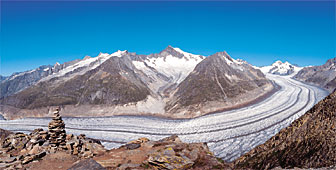Tourism: friend or foe of Aletsch World Heritage Site?

The Swiss tourist industry is launching a major campaign to promote the Alps' first natural World Heritage Site.
However, some environmentalists are concerned about a massive new influx of tourists, and feel that the region needs to be better protected. They feel that Unesco’s decision has the potential to do more harm than good by promoting mass tourism in a region already saturated with cable car and mountain railway networks.
The “Aletsch-Jungfrau-Bietschhorn” region, which was recognised by Unesco in mid December, includes the Aletsch Glacier – the longest in the Alps — and the Jungfrau, Eiger and Mönch peaks.
Grindelwald, which sits on the northern flank of the site, expects the World Heritage label to boost the local economy.
More visitors
“We hope to increase the number of visitors by about 10 per cent over the next few years,” said Joe Luggen, tourist director of the Bernese Oberland resort, shortly after Unesco announced its decision.
Luggen’s counterpart, Mario Braide, in Riederalp, one of the resorts bordering the Aletsch Glacier to the south, wants to use the label to attract more bus tours.
“There aren’t that many tourists who come on bus tours and take the cable car trip up to the resort for a look at the glacier,” says Mario Braide. “This is something we should now offer.”
The 26 lifts in Riederalp and its neighbouring resorts have the capacity to move more than 30,000 people an hour – and often do so in the ski season. The Jungfrau region, which includes Grindelwald, boasts nearly twice the number of cable cars, railways and gondolas giving tourists easy access to the heritage site. Even heli-skiing is allowed within the protected area.
Protecting the area
“A lot has to be done to protect this area from mass tourism,” says Elsbeth Flueler, director of the Swiss branch of the environmental organisation, Mountain Wilderness.
“If people really want to learn what world heritage means, they have to take their time – go slowly, look and listen,” she says. “You can’t just go up by helicopter or lift for a quick look.”
Flueler says about 2,000 skiers are flown into the area by helicopter each year and “there is a danger that this sport will increase in popularity due to the world heritage label”.
Management plan
Laudo Albrecht is less worried. An environmentalist who played a leading role in promoting the region as a heritage site, Albrecht is putting his faith in a management plan agreed on by the most important towns and villages bordering the protected area.
“We have to manage the people who are visiting the region,” says Albrecht, who has first-hand experience. He runs an environmental interpretive centre above the Aletsch Glacier.
“I don’t think there is any danger if we take measures, not only to manage the region, but also tourism,” he says.
In the “Charter of Konkordiaplatz”, the local authorities have agreed to “promote the development of the region in accordance with the principle of sustainability”.
The communities have given themselves three years to put together a management plan. As far as tourism is concerned, the emphasis will be “placed on high-quality, close-to-nature tourism which is typical of the region and guided by conservation objectives”.
Jungfrau Railway
And the charter doesn’t see the cable car and railway infrastructure as a threat. The Jungfrau Railway that takes up to 5,000 people a day up to the Jungfraujoch to admire the high alpine landscape is a cultural monument in itself, and is considered by the signatories of the charter as an environmentally sound way of reaching the heritage site.
Luggen believes the local communities are committed to “preserving the area for coming generations.”
His counterpart, Mario Braide, in Riederalp admits however, that “there is still a lot of work to be done”.
by Dale Bechtel

In compliance with the JTI standards
More: SWI swissinfo.ch certified by the Journalism Trust Initiative

You can find an overview of ongoing debates with our journalists here. Please join us!
If you want to start a conversation about a topic raised in this article or want to report factual errors, email us at english@swissinfo.ch.